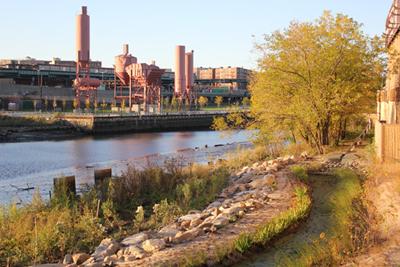
Lillian Ball, artist and environmentalist, combines her artistic talents with eco-friendly ideas. Her recent projects include the Waterwash Permanent in New York, which filters storm water before it enters rivers. (Courtesy of Green Solutions)
Artist and environmentalist Lillian Ball spoke to a group of SMU staff and students Friday afternoon about her environmental latest environmental art projects and works to bring awareness to people about environmental conservation.
Her most recent projects have been the Bronx River in New York City and the Waterwash Permanent Public Projects in Mattituck Inlet, N.Y.
Waterwash is a filtering system that absorbs and cleans storm water before it enters rivers. Waterwash’s website calls the project, “creative consulting, education and construction services for water quality improvement, wetland restoration, and storm water remediation.”
“I don’t care whether people call it art. It’s about affecting the world with ideas,” Ball said.
As a young artist, Ball moved to New York in the ’70s and was enthralled by the plumbing inside her loft. Her fascination in plumbing evolved into creating combinations of pipes and videos and making video sculptures.
In one exhibit, Ball created glass castings of sinks and displayed video projections of different bath drains. Hotels she stayed in across the world inspired the project.
Her interests in plumbing led her to recognize the problem of rainwater mixing with sewage water as they enter rivers. She saw the challenge that the population faces with sewage in major cities and was passionate about doing something to prevent it.
Her passions transitioned from art to activism when she moved to Long Island.
She was fascinated by Long Island’s environment along the shoreline and was dead set on preserving it.
With a grant and a team, she purchased 60 acres of land along the shores of Long Island and reopened it as a park after a biologist surveyed the land and deemed it as a globally rare wetland ecosystem.
She wanted to make people aware that artists were out there making a difference.
In the Queens Museum in Queens, N.Y. and Centro Andaluz de Arte Contemporane in Sevilla, Spain, she installed a video game she had engineered called, “Go Eco.” The purpose of the game was to transform ecosystems into balanced and survivable ones.
The game enticed children and taught them about the challenge and importance of ecosystem preservation.
“That’s what we do it for – the future,” Ball said.
Ball closed the lecture by defining “biomimicry,” mimicking life using imitation biological systems. She challenged the audience to use nature and mirror it back to the world.
“Art is not about illustrating but about imitating nature,” Ball said.
For more information on Lillian Ball and her works visit lillianball.com. The next Visiting Artist Lecture will be on Nov. 7.








